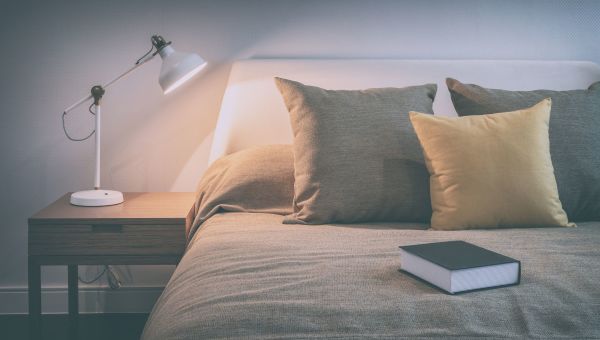7 lifestyle tips for managing atopic dermatitis
Get smart strategies for lower stress, better sleep, less itching, and fewer flare-ups.

Atopic dermatitis, also called AD or eczema, is a chronic skin condition that affects millions of adults and children in the United States, and is known for causing patches of dry, irritated, itchy, inflamed skin.
While there’s no cure for atopic dermatitis, patients with the condition have lots of tools at their disposal to help manage it. In addition to medications and therapies prescribed by a healthcare provider, treatment for atopic dermatitis usually involves a number of lifestyle changes to soothe irritated skin, minimize exposure to environmental factors that trigger flare-ups and ease the emotional burden of living with the condition.
Read on for seven lifestyle tips about stress, sleep, clothing and more.

Find ways to reduce stress
Stress and atopic dermatitis have a cyclical relationship. Atopic dermatitis can bring on a number of stressful feelings, including embarrassment, frustration and, when it disrupts sleep, exhaustion. Stress also acts as a trigger for atopic dermatitis symptoms, bringing on more of the itching, redness and inflammation.
Break out of this cycle by finding a stress-busting activity. Meditate. Go to yoga. Go for a walk in the park or woods. Exercise and eat well. Take time to read a book, play with your pet and laugh with a friend. Recognize that reducing stress is part of your treatment plan and make it a priority.

Wear the right clothing
If you have atopic dermatitis, pay extra attention to what you wear—the wrong fabrics can irritate the skin, causing flare-ups or worsened symptoms. While triggers are a little different for everyone, wool and certain synthetic fabrics (such as acrylic, nylon, polyester and spandex) have a scratchy texture (even for those who don’t have AD) that can irritate the skin or create the urge to scratch, which will make symptoms worse.
Cotton is often recommended, though the short fibers and dyes in cotton may act as irritants, and cotton is susceptible to bacteria and fungus, which may increase the risk of infection. Research has shown that clothing made from the synthetic fiber lyocell may be a comfortable option for atopic dermatitis.

Get plenty of ZZZs
Adequate sleep is associated with numerous benefits, including healthier body weight, happiness, improved memory, better sex and a healthier heart. Adequate sleep also improves immune function, reduces inflammation and lowers stress, benefits that are especially important when you’re managing atopic dermatitis.
Unfortunately, nighttime itching from AD can sabotage your sleep. To minimize its impact, follow healthy sleep habits like going to bed and waking up at the same time each day, limiting caffeine consumption and putting away your phone and other devices an hour before bedtime. In addition, you may want to talk to your healthcare provider about taking an antihistamine sedative on the nights when AD is keeping you awake.

Create the proper sleep environment
In addition to practicing healthy sleep habits, it’s important to make sure your bedroom is the optimal setting for sleep.
When it comes to the perfect temperature, everyone is a little different, but as a general rule you want your bedroom a few degrees cooler when you fall asleep; heat makes AD symptoms worse, and the last thing you want is to wake up in the middle of the night feeling itchy because you’re too warm. Turn down the thermostat or install a thermostat with a timer that adjusts the temperature when it’s time for bed. Also, avoid sleeping with open windows—fresh air is nice, but can also let in allergens which may trigger itching.
Choose linens made from a breathable material that doesn’t aggravate your skin, wash your bedding once a week and get dust mite covers for your pillows and mattress; dust mites are a common AD trigger.

Take a soothing bath
A bath or a shower a day can help ward off dry, itchy skin. You can also try adding these common household items to your bath for extra relief:
- Fragrance-free bath oils. These can help keep your skin moisturized (but they also make the tub slippery, so be careful getting in and out).
- Baking soda. Add a quarter cup to bathwater to relieve itching.
- Oatmeal. Another remedy for dry, itchy skin. Look for colloidal oatmeal in the skincare section of the pharmacy (not the oatmeal found in the cereal aisle!).
- Apple cider vinegar. This popular remedy is thought to reduce bacteria on the skin. Add between one cup and one pint to your bathwater.
Whether taking a bath or shower, remember to follow the guidelines for bathing with atopic dermatitis: Keep the water temperature lukewarm, limit your time in the water to 10 to 15 minutes, use gentle cleansers instead of soap, avoid scrubbing and apply moisturizer immediately afterward.

Keep your nails trimmed
Scratching should be avoided at all costs. Though it may provide momentary relief from your itchiness, scratching or rubbing the skin makes symptoms worse, and can even cause the skin to break or bleed, which increases the chance of an infection.
That said, the urge to scratch will be relentless at times. Even those with the best self-control will give into the urge on occasion. In fact, many people with atopic dermatitis scratch during their sleep without realizing what they’re doing.
To minimize the damage caused by scratching, keep your fingernails trimmed short, and clean them to avoid introducing bacteria into your skin. People who have a tendency to scratch during sleep can wear thin cotton gloves to protect their skin at night.

Know your triggers
One of the most effective methods for reducing atopic dermatitis flare-ups and minimizing symptoms is to learn exactly what your triggers are, and then taking steps to avoid those triggers.
In addition to seeing a doctor for an accurate diagnosis and to identify potential allergens, irritants or other causes of atopic dermatitis, you should keep a symptom journal. Use your symptom journal to note the type and severity of symptoms you are experiencing, as well as products you have used, places you have visited on a particular day, what you ate, what you wore, your stress levels, the weather, your treatments and anything else that may have impacted your symptoms. Building up months of information like this can help you recognize patterns, better understand what causes flare-ups and learn ways to manage your symptoms.
More On


video


video


video


video
